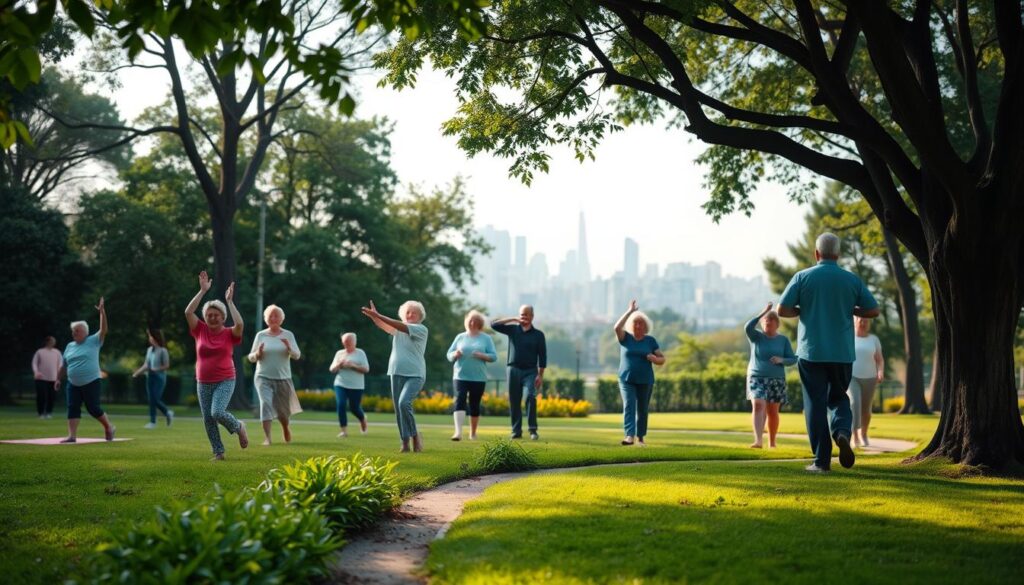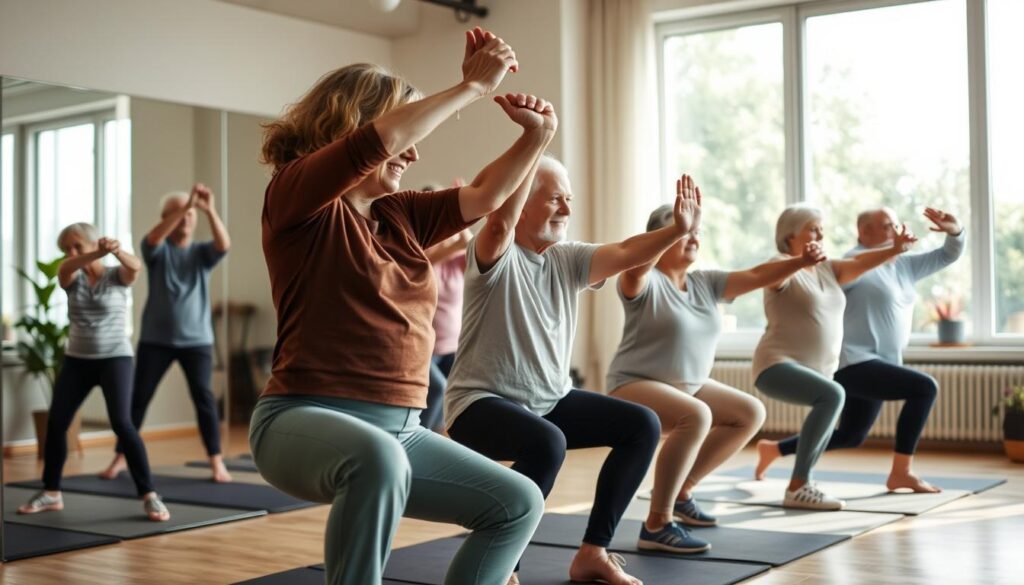Ever thought about staying active without harming your joints? Low impact exercises for seniors are a safe way to keep moving. They’re perfect for those with arthritis or osteoporosis. These workouts are designed to fit your needs, helping you stay healthy and feel good.
By adding these exercises to your day, you can boost your physical and mental health. You’ll also feel less stressed. Plus, you’ll enjoy moving in a way that feels safe and comfortable.
Key Takeaways
- Low impact exercises help maintain physical health without stressing your joints.
- These routines are beneficial for seniors with arthritis, osteoporosis, or injuries.
- Regular movement supports both physical fitness and mental well-being.
- Gentle senior workouts promote stress reduction and enhance overall quality of life.
- Low-impact activities can be easily integrated into your daily routine.
Importance of Staying Active as You Age
Staying active as you get older has many benefits. It can greatly improve your life’s quality. Regular exercise boosts both physical and mental health, helping you live longer and feel more alive.
Benefits of Regular Physical Activity
Being active can lower the risk of heart disease and stroke. Health experts say older adults should do at least 150 minutes of moderate exercise each week. This helps keep your heart healthy, improves sleep, and sharpens your mind.
It also helps you stay independent and strong. This makes your life better in many ways.
Impact on Mental Well-being
Exercise is good for your mind too. It can help with anxiety and depression, making you feel more positive. Regular physical activity makes you stronger, not just physically but mentally as well.
Understanding Low Impact Exercises
Low impact activities are key for older adults to stay healthy and active. They help reduce stress on joints while providing great benefits. This makes them perfect for seniors. Knowing about low impact exercises helps you pick the best ones for your comfort and safety.
Definition and Characteristics
Low impact exercises include walking, swimming, biking, and yoga. They improve heart health, muscle strength, and flexibility gently. Seniors can do these without worrying about getting hurt, which is important for staying active.
Doing a variety of these exercises helps keep your body balanced. It combines strength, endurance, and flexibility. For more info on these activities, check out low impact workout routines.
Why Choose Low Impact?
Low impact activities have many benefits for older adults. They lower the chance of falls and injuries while improving mobility and flexibility. Options like tai chi or yoga also help with balance, which is essential as you get older.
By choosing low intensity workouts, you get lasting fitness benefits. You can keep a routine that fits your abilities and likes.
Low Impact Exercises for Seniors
Staying fit as you age is key to your health and happiness. Low impact exercises for seniors can greatly improve your life. These workouts are gentle on your joints but give you a full workout. There are many options, each with its own benefits for different needs and likes.
Walking as a Simple Yet Effective Exercise
Walking is a simple and easy exercise. You don’t need any special gear and can walk almost anywhere. You can walk at your own pace, making it perfect for everyone. Walking helps your heart, improves blood flow, and boosts your mood, all important for seniors.
Swimming: A Full-body Workout
Swimming is a great choice for a full-body workout without hurting your joints. The water supports your body, making it easier to move and reducing injury risk. Swimming strengthens muscles and improves heart health, making it both fun and beneficial.
Cycling: Building Cardiovascular Fitness
Cycling is another way to boost your fitness. You can use a stationary bike at home or ride outside. Cycling is good for your heart, strengthens your legs, and keeps your joints moving. You can cycle at a slow pace or make it more challenging, making it a flexible and enjoyable workout.
These easy exercises help you create a balanced fitness routine. Start with different activities to find what you like best. Enjoy these low impact workouts to improve your health and have fun while doing it.
Gentle Senior Workouts You Can Do at Home
Staying active at home is key for seniors wanting to boost their strength and flexibility. Gentle workouts are easy to do and safe for all fitness levels. Doing home workouts can greatly improve your overall health and well-being.
Chair Exercises for Strength and Flexibility
Chair exercises are great for seniors who like a gentle approach. They help build strength, improve posture, and boost mobility safely. Simple moves like seated leg lifts, arm raises, and torso twists can be done from your chair.
With regular practice, you might see better balance and physical skills.
Yoga: Mindful Movement for Balance and Strength
Yoga is another excellent choice for seniors looking for low-impact workouts. It combines gentle movements with deep breathing, perfect for improving balance and reducing stress. Different poses can target various areas, increasing flexibility and calmness.
Starting with a short online class or video made for seniors can be a great way to begin this journey.
Incorporating Senior Fitness Routines into Your Lifestyle
Adding senior fitness routines to your daily life boosts your health and happiness. A planned approach lets you enjoy the benefits of regular physical activity safely and consistently. A regular workout schedule helps you make progress and see results.
Creating a Weekly Workout Schedule
Creating a weekly workout plan is key to a successful fitness journey. Mix low-impact cardio, strength training, and flexibility exercises. Set aside specific days for each to keep your routine clear and motivating. Here’s a sample schedule:
| Day | Activity | Duration |
|---|---|---|
| Monday | Walking | 30 minutes |
| Tuesday | Strength Training | 30 minutes |
| Wednesday | Balance Exercises | 30 minutes |
| Thursday | Swimming | 30 minutes |
| Friday | Chair Exercises | 30 minutes |
| Saturday | Yoga | 30 minutes |
| Sunday | Rest | – |
Setting Realistic Fitness Goals
Setting achievable fitness goals is essential for success. Start with small, specific goals like walking five more minutes each week or adding a day of strength training. Reaching these goals boosts your motivation and keeps you active. Remember, the benefits of regular physical activity will motivate you to stay active.
Safe Practices for Low Impact Activities
To stay active and avoid injuries, it’s key to follow safe practices for low impact activities. Listening to your body is very important. Always check how you feel before, during, and after exercising.
Listening to Your Body’s Needs
Your body sends important signals. If you feel pain or discomfort, stop what you’re doing. You can adjust your routine to fit your needs.
Watch for signs of tiredness and rest when needed. Knowing when to keep going and when to stop is important for a balanced workout.
Consulting with Healthcare Professionals
Talking to healthcare professionals can give you personalized advice. They help make sure your activities match your health and abilities. Fitness experts consider your medical history and offer advice tailored just for you.
Their guidance helps you understand how to exercise safely. This way, you can work out with confidence.
Easy Senior Exercises to Improve Strength and Flexibility
As you get older, it’s key to add easy exercises to your routine. These help keep your muscles strong and your body flexible. Simple exercises with your own body weight can boost muscle mass. Also, stretching regularly improves flexibility, helping you avoid injuries and move better every day.
Resistance Training with Body Weight
Bodyweight exercises are great for building strength without heavy gear. Try squats, wall push-ups, and seated leg lifts. These can be done at home and adjusted to fit your comfort and safety.
Stretching and Flexibility Exercises
Adding senior stretching exercises boosts flexibility. Try neck rolls, shoulder stretches, and hamstring stretches. These gentle moves help your body move easier and reduce stiffness. Regular stretching also relaxes your mind, making it a must for your fitness plan.
Engaging in Senior Aerobics Workouts
Senior aerobics workouts are a great way for older adults to stay active and have fun. These classes use low-impact movements that fit all fitness levels. This means everyone can join in without feeling left out.
You’ll find a friendly community in these sessions. Everyone supports and encourages each other. It’s a great place to get motivated and stay active.
Aerobic Classes Tailored for Older Adults
There are many aerobic classes made just for older adults. These classes include gentle exercises that boost heart health and fitness. You can move at your own speed, and instructors offer help for different abilities.
This supportive setting lets you enjoy the workout more. Plus, you get to be part of a group. It’s a fun way to stay active and meet new people.
Online Resources for Aerobic Workouts
Online fitness resources are also great for seniors who want to do aerobic workouts. You can do sessions at home, following along with videos. There’s a wide range of workouts, from dance to walking.
This flexibility makes it easy to fit workouts into your day. It helps you stay active, even when you’re busy.
Benefits of Group Classes and Social Engagement
Group classes offer many benefits, mainly for seniors wanting to stay active. They create a community feeling, turning workouts into social events. This makes it easier to stay motivated and keep up with fitness goals.
Being part of a fitness group can really help you stick to your exercise plans. It’s a great way to boost your commitment to regular workouts.
Finding Local Community Programs
Many places have special programs for seniors that focus on low-impact exercises. These programs are perfect for improving fitness while having fun with others. Look for local gyms, senior centers, or community groups that offer these classes.
These classes are designed to help you stay healthy and support each other. They create a friendly environment that encourages long-term health.
The Power of Social Support in Fitness
Group classes do more than just help you stay fit. They help you make friends and feel less alone. Studies show that having friends can make you happier and lower your risk of mental health problems.
As you join group classes, you’ll likely enjoy working out more. This makes it simpler to keep up with your exercise routine. For more tips on staying motivated, check out group fitness resources.
Senior Health and Fitness Tips
To stay healthy and fit, watch what you eat and drink. Senior health tips stress the need for balanced nutrition, more so for active seniors. Eating meals rich in vitamins, minerals, and protein helps with recovery and keeps energy up all day.
Nutrition for Active Seniors
Fueling your body right is key to fitness. Eating whole grains, lean proteins, fruits, and veggies supports muscle health and energy. Choosing nutrient-rich foods over empty calories boosts your workout and recovery.
Hydration and Recovery Best Practices
Staying hydrated is critical for top performance in physical activities. As you get older, your body might not feel as thirsty. So, drink water often during the day. Here are some tips for staying hydrated:
- Drink water before, during, and after working out.
- Eat hydrating foods like fruits and veggies.
- Drink at least eight cups of water a day, more if you’re active.
Good nutrition and hydration are key to your fitness journey. They help keep your body and mind healthy.
Conclusion
Engaging in low impact exercises is key for seniors to stay healthy and active. These activities boost physical fitness and mental well-being. Simple routines like walking, swimming, or joining classes can make a big difference in your life.
Staying active doesn’t mean you have to do intense workouts. Low impact exercises can improve your strength, flexibility, and heart health. It’s about living a better life, making friends, and enjoying everyday activities more.
By focusing on low impact exercises, you can live a healthier, happier life. The benefits of staying active are real, helping you stay independent and enjoy life fully as you age.
FAQ
What are low impact exercises?
Low impact exercises are activities that don’t put too much strain on your joints. They’re great for keeping you healthy. Examples include walking, swimming, cycling, and yoga.
FAQ
What are low impact exercises?
Low impact exercises are activities that don’t put too much strain on your joints. They’re great for keeping you healthy. Examples include walking, swimming, cycling, and yoga.
How do low impact exercises benefit seniors?
FAQ
What are low impact exercises?
Low impact exercises are activities that don’t put too much strain on your joints. They’re great for keeping you healthy. Examples include walking, swimming, cycling, and yoga.
FAQ
What are low impact exercises?
Low impact exercises are activities that don’t put too much strain on your joints. They’re great for keeping you healthy. Examples include walking, swimming, cycling, and yoga.
How much exercise should seniors aim for weekly?
FAQ
What are low impact exercises?
Low impact exercises are activities that don’t put too much strain on your joints. They’re great for keeping you healthy. Examples include walking, swimming, cycling, and yoga.
FAQ
What are low impact exercises?
Low impact exercises are activities that don’t put too much strain on your joints. They’re great for keeping you healthy. Examples include walking, swimming, cycling, and yoga.
What are some safe low impact exercises for older adults?
FAQ
What are low impact exercises?
Low impact exercises are activities that don’t put too much strain on your joints. They’re great for keeping you healthy. Examples include walking, swimming, cycling, and yoga.
FAQ
What are low impact exercises?
Low impact exercises are activities that don’t put too much strain on your joints. They’re great for keeping you healthy. Examples include walking, swimming, cycling, and yoga.
Are there specific low-impact aerobic classes for seniors?
FAQ
What are low impact exercises?
Low impact exercises are activities that don’t put too much strain on your joints. They’re great for keeping you healthy. Examples include walking, swimming, cycling, and yoga.
FAQ
What are low impact exercises?
Low impact exercises are activities that don’t put too much strain on your joints. They’re great for keeping you healthy. Examples include walking, swimming, cycling, and yoga.
What should I consider when creating a workout schedule?
FAQ
What are low impact exercises?
Low impact exercises are activities that don’t put too much strain on your joints. They’re great for keeping you healthy. Examples include walking, swimming, cycling, and yoga.
FAQ
What are low impact exercises?
Low impact exercises are activities that don’t put too much strain on your joints. They’re great for keeping you healthy. Examples include walking, swimming, cycling, and yoga.
How important is nutrition for seniors who exercise?
FAQ
What are low impact exercises?
Low impact exercises are activities that don’t put too much strain on your joints. They’re great for keeping you healthy. Examples include walking, swimming, cycling, and yoga.
FAQ
What are low impact exercises?
Low impact exercises are activities that don’t put too much strain on your joints. They’re great for keeping you healthy. Examples include walking, swimming, cycling, and yoga.
How can seniors maintain hydration during workouts?
FAQ
What are low impact exercises?
Low impact exercises are activities that don’t put too much strain on your joints. They’re great for keeping you healthy. Examples include walking, swimming, cycling, and yoga.
FAQ
What are low impact exercises?
Low impact exercises are activities that don’t put too much strain on your joints. They’re great for keeping you healthy. Examples include walking, swimming, cycling, and yoga.
What are the benefits of engaging in group classes for seniors?
FAQ
What are low impact exercises?
Low impact exercises are activities that don’t put too much strain on your joints. They’re great for keeping you healthy. Examples include walking, swimming, cycling, and yoga.
FAQ
What are low impact exercises?
Low impact exercises are activities that don’t put too much strain on your joints. They’re great for keeping you healthy. Examples include walking, swimming, cycling, and yoga.
Can I do low impact exercises at home?
FAQ
What are low impact exercises?
Low impact exercises are activities that don’t put too much strain on your joints. They’re great for keeping you healthy. Examples include walking, swimming, cycling, and yoga.
FAQ
What are low impact exercises?
Low impact exercises are activities that don’t put too much strain on your joints. They’re great for keeping you healthy. Examples include walking, swimming, cycling, and yoga.






